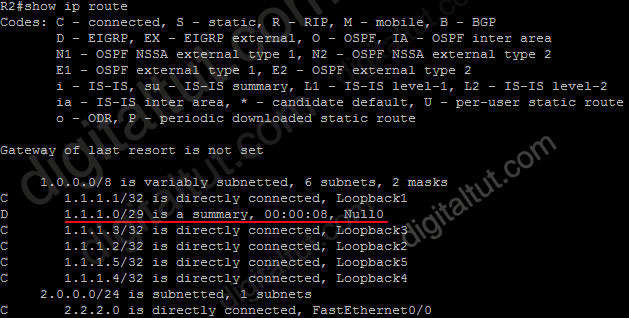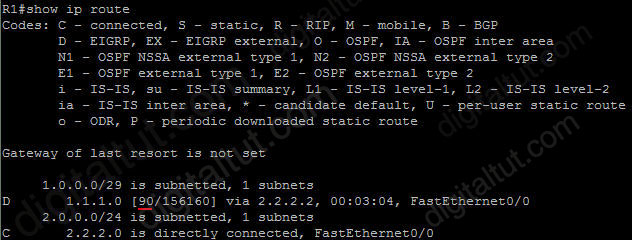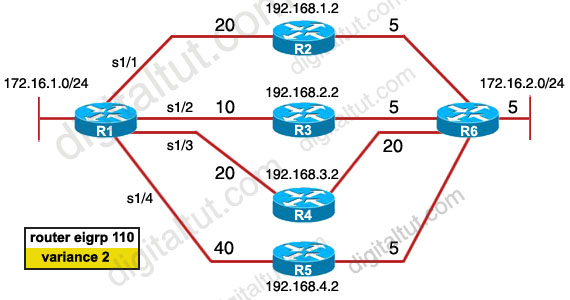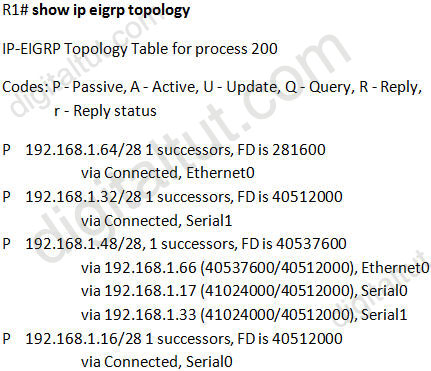EIGRP Questions 4
Here you will find answers to EIGRP – Part 4
Question 1
Which three statements are true about EIGRP route summarization? (Choose three)
A. Manual route summarization is configured in router configuration mode when the router is configured for EIGRP routing.
B. Manual route summarization is configured on the interface.
C. When manual summarization is configured, the summary route will use the metric of the largest specific metric of the summary routes.
D. The ip summary-address eigrp command generates a default route with an administrative distance of 90.
E. The ip summary-address eigrp command generates a default route with an administrative distance of 5.
F. When manual summarization is configured, the router immediately creates a route that points to null0 interface
Answer: B E F
Explanation
The ip summary-address eigrp {AS number} {address mask} command is used to configure a summary aggregate address for a specified interface. For example with the topology below:

R2 has 5 loopback interfaces but instead of advertising all these interfaces we can only advertise its summarized subnet. In this case the best summarized subnet should be 1.1.1.0/29 which includes all these 5 loopback interfaces.
R2(config)#interface fa0/0
R2(config-if)#ip summary-address eigrp 1 1.1.1.0 255.255.255.248
This configuration causes EIGRP to summarize network 1.1.1.0 and sends out Fa0/0 interface
After configuring manual EIGRP summary, the routing table of the local router will have a route to Null0:

So why is this route inserted in the routing table when doing summarization? Well, you may notice that although our summarized subnet is 1.1.1.0/29 but we don’t have all IP addresses in this subnet. Assignable IP addresses of subnet 1.1.1.0/29 are from 1.1.1.1 to 1.1.1.6. Imagine what happens if R1 sends a packet to 1.1.1.6. Because R1 do believe R2 is connected with this IP so it will send this packet to R2. But R2 does not have this IP so if R2 has a default-route to R1 (for example R1 is connected to the Internet and R2 routes all unknown destination IP packets to R1) then a loop will occur.
To solve this problem, some routing protocols automatically add a route to Null0. A packet is sent to “Null0” means that packet is dropped. Suppose that R1 sends a packet to 1.1.1.6 through R2, even R2 does not have a specific route for that IP, it does have a general route pointing to Null0 which the packet sent to 1.1.1.6 can be matched -> That packet is dropped at R2 without causing a routing loop!
By default, EIGRP summary routes are given an administrative distance value of 5. Notice that this value is only shown on the local router doing the summarization. On other routers we can still see an administrative distance of 90 in their routing table.

Question 2
After implementing EIGRP on your network, you issue the show ip eigrp traffic command on router C. The following output is shown:
RouterC#show ip eigrp traffic
IF-EIGRP Traffic Statistics for process 1
Hellos sent/received: 481/444
Updates sent/received: 41/32
Queries sent/received: 5/1
Replies sent/received: 1/4
Acks sent/received: 21/25
Input queue high water mark 2, 0 drops
SIA-Queries sent/received: 0/0
SIA-Replies sent/received: 0/0
Approximately 25 minutes later, you issue the same command again. The following output is shown:
RouterC#show ip eigrp traffic
IP-EIGRP Traffic Statistics for process 1
Hellos sent/received: 1057/1020
Updates sent/received: 41/32
Queries sent/received: 5/1
Replies sent/received: 1/4
Acks sent/received: 21/25
Input queue high water mark 2, 0 drops
SIA-Queries sent/received: 0/0
SIA-Replies sent/received: 0/0
Approximately 25 minutes later, you issue the same command a third time. The following output is shown:
RouterC#show ip eigrp traffic
IP-EIGRP Traffic Statistics for process 1
Hellos sent/received: 1754/1717
Updates sent/received: 41/32
Queries sent/received: 5/1
Replies sent/received: 1/4
Acks sent/received: 21/25
Input queue high water mark 2, 0 drops
SIA-Queries sent/received: 0/0
SIA-Replies sent/received: 0/0
What can you conclude about this network?
A. The network has been stable for at least the last 45 minutes.
B. There is a flapping link or interface, and router C knows an alternate path to the network.
C. There is a flapping link or interface, and router A does not know an alternate path to the network.
D. EIGRP is not working correctly on router C.
E. There is not enough information to make a determination.
Answer: A
Explanation
In three times using the command, the “Queries sent/received” & “Replies sent/received” are still the same -> the network is stable.
Question 3
After implementing EIGRP on your network, you issue the show ip eigrp traffic command on router C. The following output is shown:
RouterC#show ip eigrp traffic
IP-EIGRP Traffic Statistics for process 1
Hellos sent/received: 2112/2076
Updates sent/received: 47/38
Queries sent/received: 5/3
Replies sent/received: 3/4
Acks sent/received: 29/33
Input queue high water mark 2, 0 drops
SIA-Queries sent/received: 0/0
SIA-Replies sent/received: 0/0
Moments later, you issue the same command a second time and the following output is shown:
RouterC#show ip eigrp traffic
IP-EIGRP Traffic Statistics for process 1
Hellos sent/received: 2139/2104
Updates sent/received: 50/39
Queries sent/received: 5/4
Replies sent/received: 4/4
Acks sent/received: 31/37
Input queue high water mark 2, 0 drops
SIA-Queries sent/received: 0/0
SIA-Replies sent/received: 0/0
Moments later, you issue the same command a third time and the following output is shown:
RouterC#show ip eigrp traffic
IP-EIGRP Traffic Statistics for process 1
Hellos sent/received: 2162/2126
Updates sent/received: 53/42
Queries sent/received: 5/5
Replies sent/received: 5/4
Acks sent/received: 35/41
Input queue high water mark 2, 0 drops
SIA-Queries sent/received: 0/0
SIA-Replies sent/received: 0/0
What information can you determine about this network?
A. The network is stable.
B. There is a flapping link or interface, and router C knows an alternate path to the network.
C. There is a flapping link or interface, and router C does not know an alternate path to the network.
D. EIGRP is not working correctly on router C.
E. There is not enough information to make a determination.
Answer: B
Explanation
We notice that the “Queries received” number is increased so router C has been asked for a route. The “Replies sent” number is also increased -> router C knows an alternate path to the network.
Question 4
R1 and R2 are connected and are running EIGRP on all their interfaces, R1 has four interfaces, with IP address 172.16.1.1/24, 172.16.2.3/24,172.16.5.1/24, and 10.1.1.1/24. R2 has two interfaces, with IP address 172.16.1.2/24 and 192.168.1.1/24. There are other routers in the network that are connected on each of the interfaces of these two routers that are also running EIGRP. Which summary routes does R1 generate automatically (assuming auto-summarization is enable)? (choose two)
A. 192.168.1.0/24
B. 10.0.0.0/8
C. 172.16.1.0/22
D. 172.16.0.0/16
E. 10.1.1.0/24
Answer: B D
Question 5

There was an exhibit, 172.16.1.0/24 to 172.16.2.0/24 with the 4 paths with mentions of eigrp metric and asked if the variance is put to 2 in exhibit then what 2 paths are not used by eigrp routing table? (Choose two)
A. R1—R2—R6
B. R1—R3—R6
C. R1—R4—R6
D. R1—R5—R6
Answer: C D
Question 6
What does the default value of the EIGRP variance command of 1 mean?
A. Load balancing is disabled on this router.
B. The router performs equal-cost load balancing.
C. Only the path that is the feasible successor should be used.
D. The router only performs equal-cost load balancing on all paths that have a metric greater than 1.
Answer: B
Question 7
Refer to the exhibit. EIGRP has been configured on all routers in the network. The command metric weights 0 0 1 0 0 has been added to the EIGRP process so that only the delay metric is used in the path calculations. Which router will R1 select as the successor and feasible successor for Network A?

A. R4 becomes the successor for Network A and will be placed in the routing table. R2 becomes the feasible successor for Network A.
B. R4 becomes the successor for Network A and will be included in the routing table. No feasible successor will be selected as the advertised distance from R2 is higher than the feasible distance.
C. R2 becomes the successor and will be placed in the routing table. R4 becomes the feasible successor for Network A.
D. R2 becomes the successor and will be placed in the routing table. No feasible successor will be selected as the reported distance from R4 is lower than the feasible distance.
Answer: B
Question 8
Based on the exhibited output, which three statements are true? (Choose three)

A. R1 is in AS 200.
B. R1 will load balance between three paths to reach the 192.168.1.48/28 prefix because all three paths have the same advertised distance (AD) of 40512000.
C. The best path for R1 to reach the 192.168.1.48/28 prefix is via 192.168.1.66.
D. 40512000 is the advertised distance (AD) via 192.168.1.66 to reach the 192.168.1.48/28 prefix.
E. All the routes are in the passive mode because these routes are in the hold-down state.
F. All the routes are in the passive mode because R1 is in the query process for those routes.
Answer: A C D
Explanation
In the statement “IP-EIGRP Topology Table for process 200”, process 200 here means AS 200 -> A is correct.
There are 3 paths to reach network 192.168.1.48/28 but there is only 1 path in the routing table (because there is only 1 successor) so the path with least FD will be chosen -> path via 192.168.1.66 with a FD of 40537600 will be chosen -> C is correct.
The other parameter, 40512000, is the AD of that route -> D is correct.
Question 9
Characteristics of the routing protocol EIGRP? (choose two)
A. Updates are sent as broadcast.
B. Updates are sent as multicast.
C. LSAs are sent to adjacent neighbors.
D. Metric values are represented in a 32-bit format for granularity.
Answer: B D
Explanation
EIGRP updates are sent as multicast to address 224.0.0.10 -> B is correct.
EIGRP metric values, for example an entry in the “show ip route” command:
D 10.1.21.128/27 [90/156160] via 10.1.4.5, 00:00:21, FastEthernet1/0/1
EIGRP metric here is 156160 and it is a 32-bit value. For more information please read here:
Question 10
Which EIGRP packet statement is true?
A. On high-speed links, hello packets are broadcast every 5 seconds for neighbor discovery.
B. On low-speed links, hello packets are broadcast every 15 seconds for neighbor discovery.
C. Reply packets are multicast to IP address 224.0.0.10 using RTP.
D. Update packets route reliable change information only to the affected routers.
E. Reply packets are used to send routing updates.
Answer: D



I sorry not speak good English.Whats Happening i’m new to this, I stumbled upon this I’ve discovered It absolutely useful and it has helped me out loads. I am hoping to give a contribution & aid different customers like its helped me. Great job.
http://www.comtrol.com/products/rocketport-usb-serial-hubs
Please forgive my bad English.Hey there, You have done an incredible job. I will definitely Digg it and personally recommend to my friends. I am sure they’ll be benefited from this website.
http://computersolutions.com/
Please forgive my bad English.My brother recommended I might like this web site. He was totally right. This post actually made my day. You cann’t imagine just how much time I had spent for this info! Thanks!
http://www.comtrol.com/solutions/security/security-solutions/door-access-control-system-solution
I sorry for my English.I have been checking out some of your articles and i can state pretty clever stuff. I will surely bookmark your site.
http://www.comtrol.com/modbustcp
Hiya very cool web site!! Man .. Beautiful .. Amazing .. I will bookmark your website and take the feeds additionallyI am happy to seek out numerous helpful information right here within the put up, we want develop more techniques in this regard, thanks for sharing. . . . . .
Red Bottoms Louboutin https://www.pinterest.com/redbottomslouboutin
b i t . l y / 2 R O t k M W Cisco Routing and Switching foundation learning guide cover the entire course included in CCNA ICND1 and ICND2 exams.